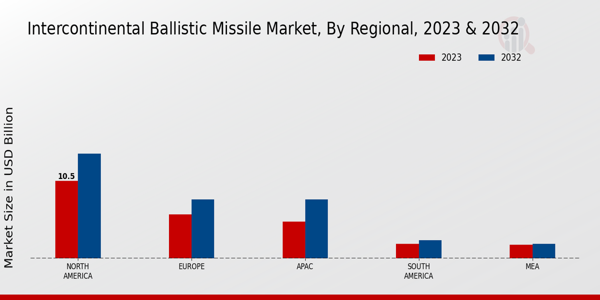Geopolitical Tensions
The ongoing geopolitical tensions among nations significantly drive the Global Intercontinental Ballistic Missile Market Industry. Countries are increasingly investing in advanced missile systems to ensure national security and deterrence capabilities. For instance, nations like the United States, Russia, and China are enhancing their ICBM arsenals amid rising concerns over regional conflicts and nuclear proliferation. This trend is reflected in the projected market value, expected to reach 25.9 USD Billion in 2024, indicating a robust demand for ICBMs as a strategic military asset.
Defense Budgets Expansion
The expansion of defense budgets across various nations plays a pivotal role in shaping the Global Intercontinental Ballistic Missile Market Industry. Governments are allocating substantial resources to bolster their military capabilities, particularly in response to perceived threats. Countries such as India and South Korea are increasing their defense expenditures, focusing on developing and acquiring advanced missile systems. This trend is indicative of a broader commitment to national security, which is expected to sustain the market's growth trajectory, with a valuation of 25.9 USD Billion anticipated in 2024.
Technological Advancements
Rapid technological advancements in missile systems are a crucial driver of the Global Intercontinental Ballistic Missile Market Industry. Innovations in guidance systems, propulsion technologies, and stealth capabilities enhance the effectiveness and reliability of ICBMs. For example, the integration of artificial intelligence and advanced materials is likely to improve missile performance and survivability. As these technologies evolve, nations are compelled to modernize their arsenals, contributing to a projected market growth rate of 3.67% CAGR from 2025 to 2035, ultimately leading to a market value of 38.5 USD Billion by 2035.
Nuclear Deterrence Strategies
Nuclear deterrence strategies remain a fundamental driver of the Global Intercontinental Ballistic Missile Market Industry. Nations continue to view ICBMs as essential components of their strategic defense postures. The doctrine of mutually assured destruction underpins the rationale for maintaining and modernizing ICBM capabilities. Countries like North Korea and Pakistan are actively pursuing advancements in their missile programs to enhance their deterrent capabilities. This ongoing emphasis on nuclear deterrence is likely to sustain demand for ICBMs, contributing to the projected market growth of 3.67% CAGR from 2025 to 2035.
International Arms Control Dynamics
The dynamics of international arms control agreements significantly influence the Global Intercontinental Ballistic Missile Market Industry. Treaties such as the New START agreement between the United States and Russia shape the landscape of nuclear arsenals and missile capabilities. While some nations pursue disarmament, others may seek to modernize their ICBM systems in response to perceived threats. This complex interplay between disarmament efforts and modernization drives market fluctuations, as countries navigate the challenges of compliance and strategic necessity.






















Leave a Comment